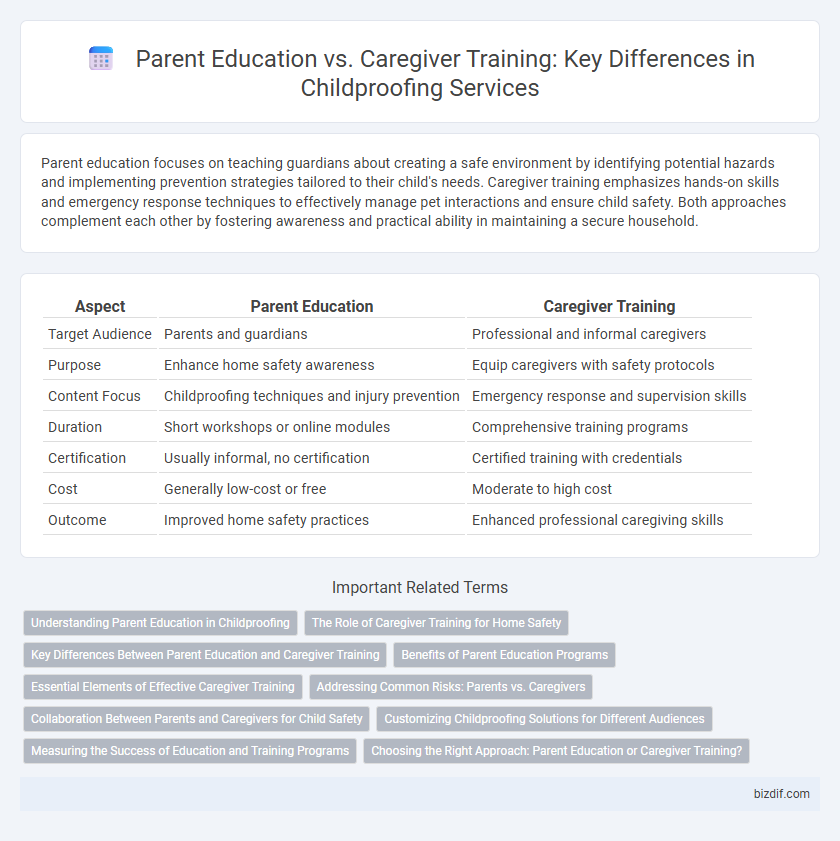Parent education focuses on teaching guardians about creating a safe environment by identifying potential hazards and implementing prevention strategies tailored to their child's needs. Caregiver training emphasizes hands-on skills and emergency response techniques to effectively manage pet interactions and ensure child safety. Both approaches complement each other by fostering awareness and practical ability in maintaining a secure household.
Table of Comparison
| Aspect | Parent Education | Caregiver Training |
|---|---|---|
| Target Audience | Parents and guardians | Professional and informal caregivers |
| Purpose | Enhance home safety awareness | Equip caregivers with safety protocols |
| Content Focus | Childproofing techniques and injury prevention | Emergency response and supervision skills |
| Duration | Short workshops or online modules | Comprehensive training programs |
| Certification | Usually informal, no certification | Certified training with credentials |
| Cost | Generally low-cost or free | Moderate to high cost |
| Outcome | Improved home safety practices | Enhanced professional caregiving skills |
Understanding Parent Education in Childproofing
Parent education in childproofing emphasizes empowering parents with knowledge about potential hazards and safety strategies within the home environment. This approach focuses on teaching parents to recognize risks and implement preventative measures tailored to their child's developmental stage. Understanding parent education is key to fostering a proactive mindset that enhances overall child safety beyond reliance on external caregiver training.
The Role of Caregiver Training for Home Safety
Caregiver training plays a critical role in enhancing home safety by equipping caregivers with practical skills to identify and mitigate potential hazards for children. Unlike general parent education, caregiver training offers targeted instruction on emergency response, safe supervision techniques, and the use of childproofing products. This specialized training ensures a consistently safe environment, reducing risks of accidents and injuries in the home.
Key Differences Between Parent Education and Caregiver Training
Parent education focuses on equipping parents with knowledge about child safety, developmental milestones, and preventive measures to create a hazard-free environment at home. Caregiver training emphasizes practical skills and emergency response techniques for babysitters, nannies, or daycare providers to manage childproofing and ensure immediate safety. The key differences lie in the target audience and application scope: parents receive broader developmental guidance, while caregivers receive hands-on, safety-specific instruction.
Benefits of Parent Education Programs
Parent education programs enhance child safety by equipping parents with essential knowledge about home hazards, emergency preparedness, and injury prevention strategies. These programs foster proactive behaviors that reduce risks and create safer environments tailored to children's developmental stages. Empowered parents can effectively implement childproofing measures, leading to sustained protection beyond routine caregiver training.
Essential Elements of Effective Caregiver Training
Effective caregiver training emphasizes hands-on practice, clear communication, and ongoing assessment to ensure child safety during childproofing. Parent education provides foundational knowledge, but caregiver training integrates practical skills with behavioral strategies to manage risks. Incorporating real-life scenarios and consistent feedback strengthens competency and confidence in maintaining secure environments for children.
Addressing Common Risks: Parents vs. Caregivers
Parent education emphasizes understanding household hazards and implementing preventive measures tailored to family routines, while caregiver training focuses on recognizing and managing risks during active supervision. Both approaches address common dangers such as choking, falls, and poisoning, but caregiver training often includes emergency response techniques specific to non-parental adults. Prioritizing customized strategies for each role enhances overall child safety by mitigating diverse risk factors in home and care environments.
Collaboration Between Parents and Caregivers for Child Safety
Effective childproofing relies on seamless collaboration between parents and caregivers to establish consistent safety practices. Parent education ensures awareness of potential hazards and home safety protocols, while caregiver training equips individuals with practical skills to respond to emergencies and maintain a secure environment. Shared communication and joint responsibility are essential for minimizing risks and promoting the highest standards of child safety.
Customizing Childproofing Solutions for Different Audiences
Parent education emphasizes teaching safety practices tailored to their home environment, ensuring parents understand specific hazards and prevention strategies. Caregiver training focuses on equipping professional caregivers with standardized protocols and emergency responses for various childcare settings. Customizing childproofing solutions requires addressing the unique needs and responsibilities of each audience to maximize safety and effectiveness.
Measuring the Success of Education and Training Programs
Measuring the success of parent education and caregiver training programs in childproofing involves assessing knowledge retention, behavioral changes, and the reduction of home accidents. Quantitative metrics such as pre- and post-training assessments, as well as qualitative feedback from participants, provide critical insights into program effectiveness. Continuous evaluation ensures that both parents and caregivers implement safety measures correctly, ultimately enhancing child safety outcomes.
Choosing the Right Approach: Parent Education or Caregiver Training?
Choosing the right approach between parent education and caregiver training depends on the child's environment and the primary adults involved in daily care. Parent education empowers families with knowledge about childproofing techniques, safety protocols, and hazard identification directly tailored to the home setting. Caregiver training extends this expertise to external caregivers or daycare providers, ensuring consistency in child safety practices across all supervision environments.
Parent education vs Caregiver training Infographic

 bizdif.com
bizdif.com